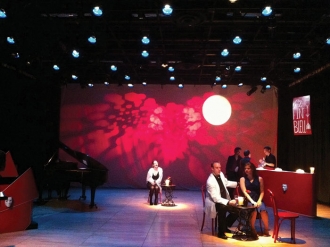Latin IS America
Musique 21
A Theatre of Music production featuring guest composer Ricardo Zohn-Muldoon.

CONCERT
Musique 21: This Love
Monday, April 27, 7:30 p.m.
Fairchild Theatre, MSU Auditorium. Free
For the event page, click here.
Kevin Noe, ensemble director
Ricardo Zohn-Muldoon, guest composer
This light, this fire that devours,
this grey landscape that surrounds me,
this sorrow centered round one idea,
this anguish of sky, world and time.
this love.
Program
Candelabra III
Ricardo Zohn-Muldoon
Sol de las Esperanzas (Sun of Hopes) world premiere
Ivette Herryman Rodríguez
Dream Images (Love-Death Music)
Gemini F. G. L. from Makrokosmos Book 1
George Crumb
Ligare
Alexandre Lunsqui
11 echoes of Autumn
George Crumb
yo no-tú sí-yo tú-sí no
Ricardo Zohn-Muldoon
Musique 21
is a project-based group at MSU with flexible instrumentation that focuses on new works. The troupe pushes the envelope of what a 21st-century performance can be by using a variety of media including theatre, film, and movement.
Program Notes
Ricardo Zohn-Muldoon on his music
Candelabra III
This work was written for the Sirius Ensemble under the auspices of the U.S./México Fund for Culture. It is part of a series of works united by the same compositional principle and original material. Each successive work is an expanded version of the previous one, successively developing in greater detail and length the previous musical materials. Each Candelabra is composed for a different instrumental combination.
All the works in the series were conceived as memorials to members of my father’s family, Jews who fled Vienna in 1938 to Tlaquepaque, a small village near Guadalajara, México. Despite this radical cultural transplantation, the family flourished. Hence the analogy to this particular cactus, which grows and flowers even in inhospitable surroundings and so named for its resemblance to the candelabra.
Candelabra III was written for my father. Like the others works in the series, a minute musical module is expressed in multiple dimensions such as time, pitch and timbre, creating a structure that emulates the homonymous cactus. For example, at the beginning of the piece the crotales and piano present a brief melodic figure in unison, but with the peculiarity that the piano adds a second “ornamental” note for each note of the crotales. These piano ornaments are actually quicker renditions of the same melody being presented in the slower unison figure. Finally, harmonics in the strings elongate the resonance of these melodic notes, accumulating as a harmony that sustains underneath. We thus hear this musical idea in distinct temporal planes and colors, simultaneously as line, ornament, and harmony, just as in the cactus we see the small leaves growing on bigger leaves of the same design, which in turn are perched on masses of even larger ones that have coalesced as a “trunk.” The piece continues to unfold in a similar way, with further ramifications of the idea being expressed with increasing complexity contrapuntally, harmonically, and rhythmically. At the climax of the piece, all the lines, harmonies, and figures are nested in a massive chordal texture and, soon after, the rhythm stabilizes in a strong, regular beat. This metaphorically represents the “trunk” that sustains the entire structure, the pulsating heart of the piece.
Yo no / tú sí / yo tú / sí no
yo no / tú sí / yo tú / sí no is a musical setting of texts by Raúl Aceves, a poet and author who resides in Guadalajara, México. The works takes its title from the ninth stanza of his poem Tú.
IX
Existo más gracias a ti
aquí donde tú ya no
aunque tú ya existas allá
dónde yo no / tú sí
yo tú / sí no.
Attempting to capture the light quality but deep sensitivity of Aceves’ texts helped me to manifest more clearly a part of my musical sensibility that is rooted in popular and folkloric music. This happened mostly “on its own:” the musical impulses sprang from the texts, and I kept true to them to the best of my ability. I find Raúl Aceves’ work deeply inspiring and moving. The texts I selected for this setting have a common thread. They all address the feelings and mind-state (the wonder and deep sense of joy) we experience in being moved to love someone. These texts are also bound by certain recurrent images, such as the eyes as the window that separates reality and memory (our internal reality), and a metaphoric connection between the fluid, elusive nature of water, and love (a.la.ka.sa.).
Ivette Herryman Rodríguez on her music
Sol de las Esperanzas
“Sun of Hopes,” commissioned by Kevin Noe for Musique 21, is a celebration of a vocal style of flamenco music called Cante Hondo, “Deep Song,” a music that I discovered through the reading of Federico Garcia Lorca’s poetry. The work is based on the poem Canción Otoñal, “Autumn Song.” The Spanish poet, despite his personal struggles, found hope in the “light of the sun, the clear water, the new moon, and the heart of children.”


